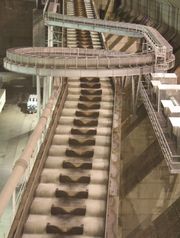forum
library
tutorial
contact

Northwest Salmon Numbers Surge
to Highest Level Since 1930s
by Joshua Babcock and Miles Bruck Murrow
KREM, October 15, 2014
|
the film forum library tutorial contact |

|
Northwest Salmon Numbers Surge
by Joshua Babcock and Miles Bruck Murrow
|
 After a strong year last fall, the growing salmon runs are raising hope that improved fish passages, cold ocean temperatures, and better hatcheries are leading to a resurgence of the Northwest icon.
After a strong year last fall, the growing salmon runs are raising hope that improved fish passages, cold ocean temperatures, and better hatcheries are leading to a resurgence of the Northwest icon.
"The return of fall Chinook salmon over Bonneville Dam over the last two years is double the 10-yearaverage," Dean Holecek, a fish biologist with the U.S. Army Corps of Engineers said. "It looks like it will be one of the largest runs since 1938," the first year Bonneville Dam counted fall Chinook.
State experts predict 1.5 million Chinook and 638,000 Coho will migrate to spawning grounds along the river system. That's about 500,000 more Chinook and 575,000 more Coho than biologists recorded last year.
Counters at Bonneville Dam, the first of eight dams on the Columbia River, indicate Chinook and Coho are on pace for record runs. Across the string of dams along the Columbia system, biologists are seeing similar increases in the salmon run, which ends in mid-December.
"This is a major development within the ecological community because finally something is working," said Gary Thorgaard, a fish genetics professor at Washington State University.
Though it is difficult to identify a single reason for the increase, Thorgaard and others say that cooler temperatures in the Pacific Ocean are helping fish.
"The cold upwelling in the ocean water provides more nutrients for the salmon and dissuades predators who seek warmer water," Thorgaard said.
Mark Bagdovitz, the Columbia River Basin coordinator for the U.S. Fish and Wildlife Service,said the salmon have also benefited from spilling water over the dams, which helps the fish avoid turbines. Spilling has been used for decades, but since 2006, federal law has required that dams spill a certain amount of water to help the fish.
"Fish don't go through turbines well," Bagdovitz said. "The mortality rate is about 15 to 20 percent."
But in the complicated river ecosystem, the practice can also harm some fish by raising nitrogen levels. Dan Swecker, executive director of the Washington Fish Growers Association, credits the selection of genetically superior wild fish used to fertilize the hatcheries.
Michael Milstein, a fisheries spokesman with the National Oceanic Atmospheric Administration, said it is important to understand why the salmon numbers are increasing, but the end result seems clear: more fish are surviving to spawn upstream.
"There have never been this many fish traveling up past Bonneville Dam," Milstein said.

learn more on topics covered in the film
see the video
read the script
learn the songs
discussion forum
